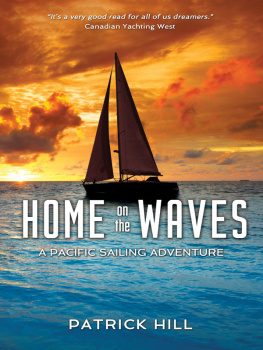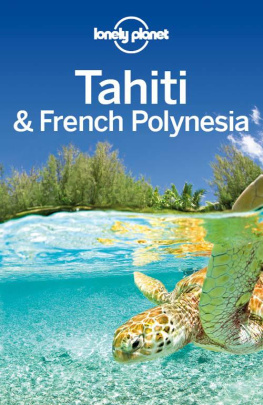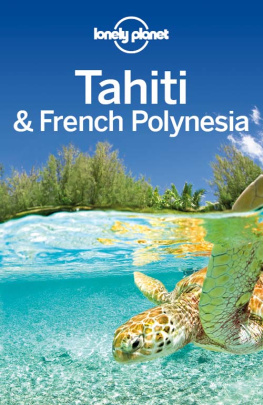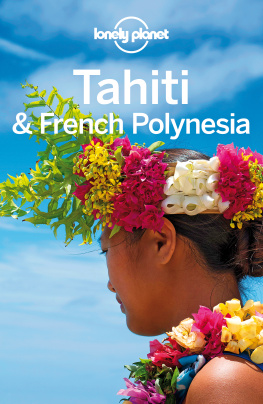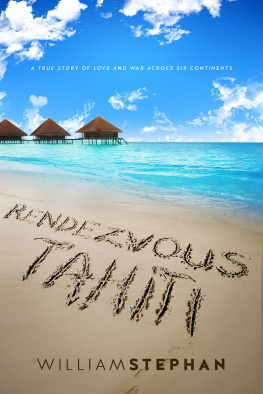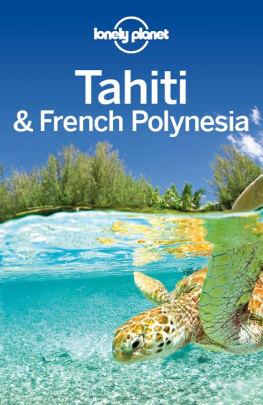

Burtyrki Books 2020, all rights reserved. No part of this publication may be reproduced, stored in a retrieval system or transmitted by any means, electrical, mechanical or otherwise without the written permission of the copyright holder.
Publishers Note
Although in most cases we have retained the Authors original spelling and grammar to authentically reproduce the work of the Author and the original intent of such material, some additional notes and clarifications have been added for the modern readers benefit.
We have also made every effort to include all maps and illustrations of the original edition the limitations of formatting do not allow of including larger maps, we will upload as many of these maps as possible.
TAHITI
Voyage Through Paradise
The story of a small boat passage through the Society Islands
By
GEORGE T. EGGLESTON

With a photographic log by the author


TABLE OF CONTENTS
Contents
TAHITI
Voyage Through Paradise

DEDICATION
TO HAZEL
Acknowledgments
WHEN ONE spends the better part of a year outside the country living the events narrated in this book many acknowledgments are in order. The author is, first of all, indebted to his mother who cared for our daughter, Day, while we were away. Without her tender indulgence the voyage could never have been attempted.
In Tahiti we were indebted to the James Norman Halls for their hospitality and encouragement. We thank Clayton Knight, an old friend of the Halls, for introducing us to them. For the many heart-warming contacts mentioned in the story we want to pay especial tribute to those noble people, the Tahitians who on all ten islands became our friends.
We are grateful to Harry Close for having been in Papeete with Viator at the precise moment we met him. We are also indebted to him for the interesting picture on page 215. To Dwight Long, thanks for the fine pictures on pages 178, 220, 222, and 231.
In the actual preparation of the book for press we are thankful for the publishing imagination of Devin Garrity and Thomas OConor Sloane III of the Devin-Adair Company. For the care and handling of the pictures and text for printing we thank Harry Wisner, Philip Kolb, Eustis Rawcliffe, James Dobyns, Ken Williams, Jr. and Anson Hosley of the Case-Hoyt Corporation.
PREFACE

A wonderful lot of stories have been written about the islands of the South Pacific. Long before the battles of the greatest war had made people conscious of names like the Marianas, The Gilberts, The Solomons, The New Hebrides, and the Fijis, my wife and I had gathered a shelf of South Pacific tales that touched upon islands of a vast triangle stretching from New Zealand to Hawaii to Peru. In our armchair travels we had come to know many magic place-names: the Australs, the Tuamotus, the Marquesas, Tonga, Samoa, Easter Island, and Pitcairn. And, as we read more and more, we learned that the unquestioned queen of all the islands was Tahiti, rising majestically over its immediate group, the Society Islands, and supra-supreme over all the ten thousand and one islands of the Pacific.
We read tributes to Tahiti and her sister isles by Bougainville, Darwin, and Captain Cook; by Herman Melville, Robert Louis Stevenson, and Jack London. Two hundred years ago, navigator Bougainville had said of Tahiti: I thought I was walking in the Garden of Eden. Robert Louis Stevenson called the Tahitians Gods bestat least Gods sweetest works. The late James Norman Hall spent most of his life writing of the wondrous charms of this particular group of islands, and died in the spot he loved above all others on this earth, Tahiti.
We guessed, thanks to our reading that we might find an idle yacht in Tahitis port of Papeete and chatter it for a leisurely dream cruise into the shallow lagoons and fabled bays of the outer islands of the Society group.
Our guess came true. Papeete was, is, and always will be a port of crewless yachts waiting for charters that never come. We are the only ones, so far as we know, who have discovered and acted upon this yachting phenomenon. As we did it, others can do the same.
G. T. E.
Hickory Bluff
Rowayton, Conn.
The First IslandTAHITI

IT WAS a spring night, yet it held for us all the pleasant tensions of a night before Christmas. It had been fourteen days since we boarded the tiny French steamer at Panama to begin the long, slow crawl across the equatorial Pacific. The Ville de Strasbourg, en route from Marseille to New Caledonia with a semi-annual supply of building materials and administrators for the Colonial possessions, had been our only means of getting to the Society Islands. She was to make one stop, Tahiti, before proceeding to the western Pacific.
The days at sea had been so quiet, the weather so calm, that a sailing canoe might have made the 4,493-mile traverse without taking a single dollup of water over the gunwales.
We gave up trying to sleep at about midnight. In our dressing robes, we climbed to the bridge of the vessel to gaze ahead into the moon and starlight. At 4:30 a.m. a vision appeared. We saw a great high mass of island, shrouded in misty moonglow. Soon the first rays of dawn dispersed the haze over our bows, and Tahiti lay before us, a bright chartreuse cut-out on a staging of royal blue. Presently we saw purple-gray cloud masses encircling a series of mighty peaks as deep-creasing shadows appeared where volcanic valleys dropped to the sea. We rounded Point Venus light and the silhouette of the high mountain, Orohena; an hour later we were off the pass of the legendary capital of the Pacific, Papeete.
As the Ville eased her rusty hulk along the ancient quayside, we looked past a forest of trading-schooner spars to the snug Quai du Commerce, acacia-shaded and drowsy in the heavy-scented morning air. Here and there a gleam of pastel-colored stucco picked up a bit of sunshine. A half dozen bicycles glided through the lights and shadows, while a bus full of outlanders came to a stop near the dock, unloading to the accompaniment of shrill laughter and the squeals of trussed pigs carried on the roof.
A very white sea bird glided to water level near us, its under plumage picking up the reflected pale green of the lagoon.
We had a considerable accumulation of gear to cart to the customs table, located in one end of a strong-smelling copra storage shed. But the friendly customs officer didnt bother about anything except our phonograph records. These had to be held for inspection, and were returned to us when we left the island. Our bags, full of cameras, photo supplies, charts, sextant, and chronometer, went through unopened and unchallenged. Later we were amused to reflect upon all the boxes of spare things we had carried over those thousands of miles of ocean. Local Chinese stores stocked every kind of sundry in abundance. We were to find American cigarettes, camera film tropically sealed, almost every brand of American toothpaste, flashlight bulbs, rubber bands, paper clips, typewriter ribbons, and even yo-yos.
Next page


